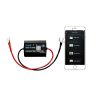What is the difference between a digital battery tester and a traditional load tester?
1. BATTERY TESTER SIZE
Digital battery testers are more compact and lighter than traditional load testers. Traditional load testers require the batteries to be hooked up to a large resistor, which mimics the amps that a starter motor places on a battery. Load testers come in many sizes, but the high quality commercial ones can weigh 50lbs. Some require stands, which limits portability. Digital battery testers, like the Lancol Micro series.
2. BATTERY TESTER INFORMATION
While a load tester provides crystal clear information about whether the battery can sustain the given electrical load, that is all the information the tester will provide. Digital battery testers will test for a bad cell, report on the number of cold cranking amps, report on surface charge condition, and will print a date stamped digital read out. The car battery tester Micro 10,just get testing result from phone App

3. ESTABLISH A TREND LINE
Load testers are straightforward and provide either a pass or fail. Using digital testers to establish a base line and then monitor progress can provide auto shops and customers with unlimited information about their battery at every stage of the life cycle. Digital battery testers can provide early indicators of whether the battery is likely to fail. Replacing batteries at the slightest indication of failure can keep commercial drivers off the side of the road and out of the service shop.
4. DURATION OF TESTING
Traditional battery testers require set up time and then take 10-15 seconds to register a reading. Digital battery testers require only 2 seconds for measurements and provide a print out for reference. Time is money.

Advances in battery testing and diagnostics technology have happened rapidly and the auto shops who purchase affordable, commercial grade digital testers, like Lancol, will come out on top.


